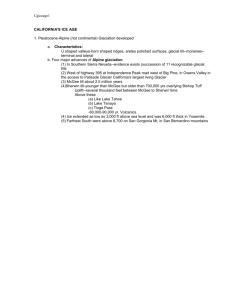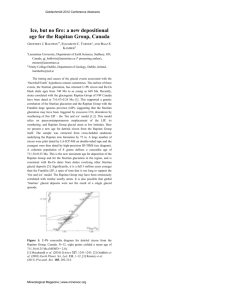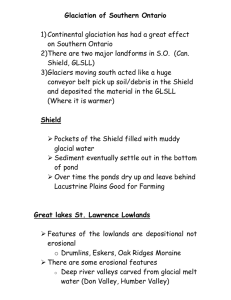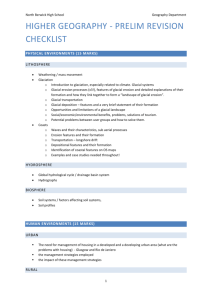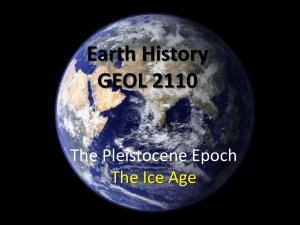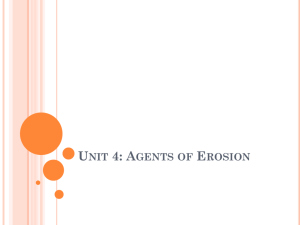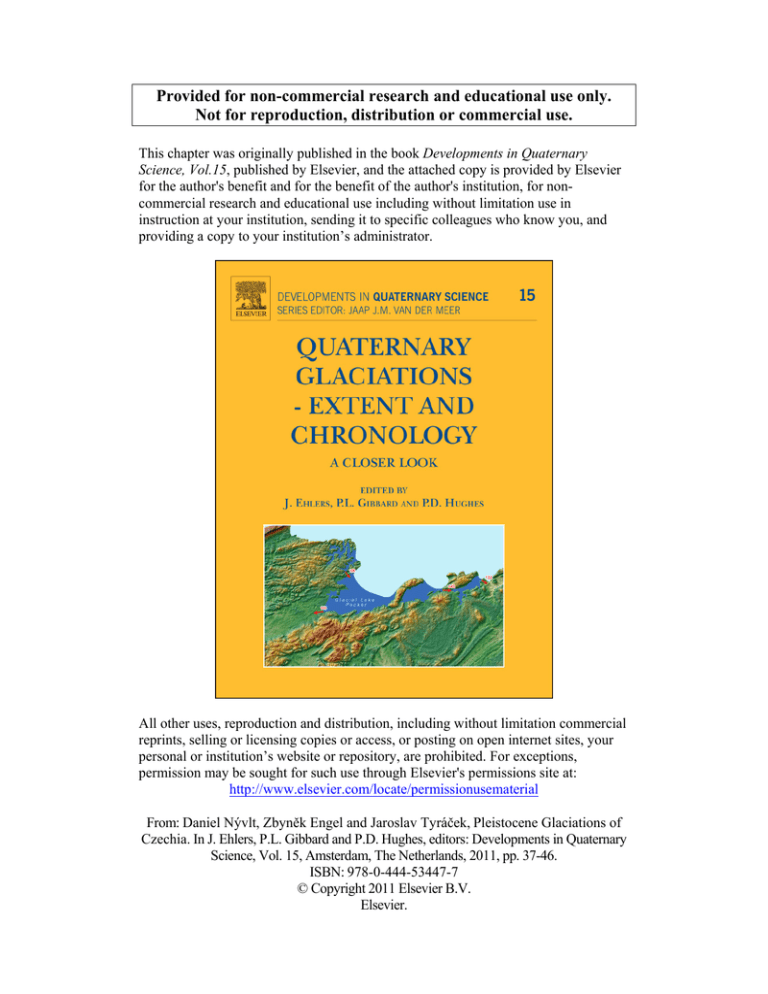
Provided for non-commercial research and educational use only.
Not for reproduction, distribution or commercial use.
This chapter was originally published in the book Developments in Quaternary
Science, Vol.15, published by Elsevier, and the attached copy is provided by Elsevier
for the author's benefit and for the benefit of the author's institution, for noncommercial research and educational use including without limitation use in
instruction at your institution, sending it to specific colleagues who know you, and
providing a copy to your institution’s administrator.
All other uses, reproduction and distribution, including without limitation commercial
reprints, selling or licensing copies or access, or posting on open internet sites, your
personal or institution’s website or repository, are prohibited. For exceptions,
permission may be sought for such use through Elsevier's permissions site at:
http://www.elsevier.com/locate/permissionusematerial
From: Daniel Nývlt, Zbyněk Engel and Jaroslav Tyráček, Pleistocene Glaciations of
Czechia. In J. Ehlers, P.L. Gibbard and P.D. Hughes, editors: Developments in Quaternary
Science, Vol. 15, Amsterdam, The Netherlands, 2011, pp. 37-46.
ISBN: 978-0-444-53447-7
© Copyright 2011 Elsevier B.V.
Elsevier.
Author's personal copy
Chapter 4
Pleistocene Glaciations of Czechia
Daniel Nývlt1,*, Zbyněk Engel2 and Jaroslav Tyráček3,{
1
Czech Geological Survey, Brno branch, Leitnerova 22, 658 69 Brno, Czech Republic
2
Department of Physical Geography and Geoecology, Faculty of Science, Charles University in Prague, Albertov 6, 128 43 Praha 2, Czech Republic
Czech Geological Survey, Klárov 3, 118 21 Praha, Czech Republic
3
*Correspondence and requests for materials should be addressed to Daniel Nývlt. E-mail: daniel.nyvlt@geology.cz
{
This study is dedicated to the memory of our colleague Jaroslav Tyráček (1931-2010) for his substantial contribution to the study of Pleistocene
glaciations in our territory
4.1. INTRODUCTION
This is a review of current evidence of continental and mountain glaciation in Czechia and provides a closer look at the
Pleistocene glacial limits and chronology for the region. It
is based on numerous works published during more than a
century of research in the Czech territory. The reference list,
therefore, can include only the most important studies or
those published in world languages. This chapter is divided
into two main parts. The first part focuses on the products of
the continental glaciations, whilst the second part deals with
the local mountain glaciations in the Sudetes and the Šumava
Mountains. Three Northern European ice sheets affected
Czech territory during both the Elsterian (marine isotope
stage (MIS) 16 and 12) and older Saalian (MIS 6) glaciations.
They reached as far as northern Bohemia, northern Moravia
and Czech Silesia. In contrast, mountain glaciation was limited to the Krkonoše (Giant), the Šumava (Bohemian Forest)
and Hrubý Jesenı́k (Altvatergebirge in German) Mountains.
The timing of mountain glaciation is still poorly known. Sedimentary and numerical evidence is available for both the
Weichselian-age glaciations, but the chronostratigraphical
framework of the pre-Weichselian glaciation remains questionable. Recent geomorphological, sedimentological and
chronological studies have substantially improved the understanding of Pleistocene glaciations in Czechia, providing
new information on their extent and chronology.
4.2. CONTINENTAL GLACIATION
The first evidence of continental glaciation in Czechia was already established by the end of the nineteenth century (e.g.
Danzig, 1886; Tausch, 1889; Cammerlander, 1891). Czech
territory was marginally overridden by northern European
ice sheets during three separate events. They left behind considerable masses of glacial sediments, arranged mostly in a
Developments in Quaternary Science. Vol. 15, doi: 10.1016/B978-0-444-53447-7.00004-0
ISSN: 1571-0866, # 2011 Elsevier B.V. All rights reserved.
relatively narrow belt parallel to the general trend of the northern frontier mountain ridges. The maximum glacial extent is
marked either by glacial deposits or by Nordic rocks spread on
the land surface. This line has been called the ‘flint-line’
(Feuersteinlinie) because the most commonly represented lithology is flint derived from the Baltic region. More recent
studies have focused not only exclusively on glacial sediments
but also on glacial erosional morphological features. They
have provided better control on the exact glacial limits, particularly in the granite landscapes of northern Bohemia. Numerous sedimentological and petrological studies of glacial
deposits from Czechia (e.g. Růžička, 1980, 1995; Nývlt and
Hoare, 2000, 2011; Sikorová et al., 2006; Vı́šek and Nývlt,
2006) are not discussed here, except for those which are directly connected to the topic of this contribution. Dating of individual ice-sheet advances has also been the subject of recent
studies, but only a few results have been published to date (e.g.
Nývlt, 2008; Nývlt et al., 2008). However, further studies are
in progress and will be published in the near future.
Czech territory contains evidence of three Middle Pleistocene glaciations during which glaciers advanced into two
regions, northern Bohemia and northern Moravia, and to a
larger extent into Czech Silesia. The area was especially
invaded by ice of the Polish Odra lobe (e.g. Hesemann,
1932; Piotrowski, 1998). Only the eastern glaciated part of
northern Moravia and Czech Silesia was glaciated by ice
sheets that combined both the Vistula and Odra lobes (e.g.
Marks, 2005). The local morphology at the glacier margin
affected the extent of the ice sheets, such that the glaciers
penetrated further to the south in the low-lying Zittau and
Ostrava Basins or in the Moravian Gate. The fronts of the
advancing ice-sheet lobes crossed the local or regional
watersheds in some places. The main European watershed
was crossed by the ice at the Poruba Gate, and the associated
proglacial outwash drained into the Danube River catchment
(e.g. Tyráček, 1961, 1963, 2011). The Sudetes mountain belt
37
Author's personal copy
38
was crossed by an outlet of the ice sheet in the Jı́trava Saddle,
thereby penetrating into the inner part of the Bohemian Highlands, that is, to the Labe (Elbe) River catchment (e.g. Danzig, 1886; Šibrava, 1967; Macoun and Králı́k, 1995). These
key areas are important for direct correlation of glacial sequences with fluvial terrace-deposit systems of the rivers
in the Labe and Danube catchments (e.g. Šibrava, 1967;
Macoun and Králı́k, 1995; Tyráček and Havlı́ček, 2009; Tyráček, 2011). Morphostratigraphical correlation was formerly the only available approach for dating of individual
glacial deposits and landforms. Individual stratigraphical
systems, based on these correlations, were developed for
the continental glaciation in northern Bohemia and northern
Moravia and Czech Silesia (the most recent are given by
Macoun and Králı́k, 1995 or Růžička, 2004).
4.3. ELSTERIAN GLACIATIONS
Traditionally two separate advances of Northern European ice
sheets reaching the northern parts of Czechia were linked to
the Elsterian Stage (e.g. Šibrava, 1967; Macoun, 1985). They
are correlated with MIS 16 and 12 (e.g. Šibrava et al., 1986;
Lindner et al., 2004) and locally to Elsterian 1 and 2 in
Germany (Eissmann, 1997, 2002) or the Sanian 1 and 2 in
Poland (Lindner et al., 2004; Marks, 2004, 2005). Individual
glaciations are described separately for both glaciated areas of
Czechia, they could be correlated via the area of Poland.
4.3.1. Northern Bohemia
During the Elsterian 1 (MIS 16 ¼ Donian glaciation of
Russia; Chapter 26), the Northern European ice sheet covered Šluknov Hilly land, Frýdlant Hilly land and Zittau Basin, the frontal lobe crossed the Jı́trava Saddle in the Ještěd
Range and entered the Ralsko Hilly land, that is, the catchments of Ploučnice and Jizera Rivers (Šibrava, 1967;
Králı́k, 1989; Macoun and Králı́k, 1995; Nývlt, 2008).
The Elsterian 1 glaciation was the most extensive continental glaciation in northern Bohemia. The glacial limit
has been mapped in detail in the Šluknov Hilly land (Nývlt,
2001, 2008) district. In contrast to the adjoining parts, this
area was only affected by the older Elsterian 1 glacier. This
glaciation originated by the confluence of two individual
ice-sheet lobes that advanced from the North and East to
join along the watershed between the Labe and Oder River
catchments (Fig. 4.1). The maximum advance of this ice
sheet has been dated on the depth profile of proglacial
glaciofluvial deposits using 10Be cosmogenic nuclide to
606 53 ka BP (Nývlt, 2008). This should correspond to
MIS 16, which culminated 620–635 ka BP (EPICA
Community Members, 2004; Jouzel et al., 2007).
The best-preserved glacial sequence for study of glacial
stratigraphy of these Middle Pleitocene deposits is in the
Zittau Basin, where both Elsterian tills are preserved in
Quaternary Glaciations - Extent and Chronology
superposition at different sites (Šibrava, 1967). Here the
Elsterian 1 glaciation was the most extensive, the ice-sheet
front crossed the Jı́trava and Hornı́ Saddle and penetrated
further to the Ralsko Hilly land (Šibrava, 1967; Králı́k,
1989). The Elsterian 2 ice front crossed also the Jı́trava Saddle and deposited a terminal moraine at Jı́trava (Šibrava,
1967; Králı́k, 1989). Proglacial glaciofluvial accumulations
deposited in the Ploučnice river catchment have been
correlated with the terrace deposits sequence of the Labe
River (Grahmann, 1933; Šibrava, 1967; Tyráček and
Havlı́ček, 2009).
Remnants of both Elsterian glaciations are also found in
the Frýdlant Hilly land (Králı́k, 1989; Macoun and Králı́k,
1995). Here it seems that the Elsterian 1 glaciation was
less extensive than that during the subsequent Elsterian 2
(Králı́k, 1989; Nývlt, 2003). The ice sheet crossing of the
Jizerské hory mountain belt, through the Oldřichov col at
478 m a.s.l. (Králı́k, 1989), took place during the Elsterian
2 Stage (Nývlt, 2003; Nývlt and Hoare, 2011). The glaciation limit in the northern slope of the Jizerské hory, which is
connected with the Elsterian 2 ice sheet, was recently
mapped by Černá 2011. Here the glaciation limit was
delimited using a combination of different geomorphological methods to the altitude of 470–490 m a.s.l. (Traczyk
and Engel, 2006; Černá 2011; Černá and Engel, 2011;
Fig. 4.2). The highest site with glacial sediments in northern
Bohemia lies in the Anděl Saddle at 522 m (Janásková and
Engel, 2009), in the northern part of the Jizerské hory. Here
the glaciation is represented by proglacial glaciofluvial sediments deposited in front of the ice-sheet advancing to the
saddle from the east. The precise position of the glacier has
not been determined, but the glacier’s surface must have
been higher than that of the saddle, because its melt waters
were draining to the west (Janásková and Engel, 2009).
Eissmann (1997, 2002) proposed the concept of a huge
ice-dammed lake in the Labe River valley upstream of
the present Bad Schandau, where, according to him, the
Elsterian ice sheet terminated. Some rhythmically bedded
clays occur at the Foksche Höhe in Děčı́n (Šibrava, 1967)
or in Ctiněves near the Řı́p Hill (Žebera, 1961), but their
glacial meltwater origin has never been proved (e.g. Žebera,
1974; Růžička, 2004). Other clay beds have been identified
in several river terrace sequences of the Vltava and Labe
(Elbe) rivers at various altitudes in the Řı́p area. However,
they do not match any contingent ice-dammed lake. Indeed,
no traces of such a huge ice-dammed lake have been found
in the Czech part of the Labe River valley, so far. Therefore,
Eissmann’s (1997, 2002) interpretation of the occurrence of
a huge ice-dammed lake in the inner Bohemian Massif during the Elsterian cannot be accepted. If some temporary glacial lake existed around Bad Schandau, then it must have
drained beneath the glacier, through the fissures within
the ice body or along the glacier front on German territory
(Ehlers et al., 2004).
Author's personal copy
Chapter 4
Pleistocene Glaciations of Czechia
39
FIGURE 4.1 Palaeogeographical reconstruction of the Elsterian glaciation in the Šluknov Hilly land (modified from Nývlt, 2008).
FIGURE 4.2 Profile line through the northern slope of the Jizerské hory reconstructing glaciation limit using Schmidt hammer measurements and geomorphological analyses of glacial and periglacial landforms (from Černá, 2011).
Author's personal copy
40
4.3.2. Northern Moravia and Czech Silesia
The Elsterian glaciation also extended into northern
Moravia and Czech Silesia, where from the west to east
the foothills of the Rychlebské, the Hrubý Jesenı́k and
the Zlatohorská Highlands were glaciated (e.g. Macoun et
al., 1965; Prosová, 1981; Macoun and Králı́k, 1995; Sikorová et al., 2006). The ice sheet advanced into the Ostrava
Basin, the Opava Hilly land and the Moravian Gate
(Macoun et al., 1965; Macoun, 1980; Macoun and Králı́k,
1995; Tyráček, 2011) penetrating up to 40 km towards
the south of the prevalent maximum glacial limit making
an outlet ice-sheet lobe (Fig. 4.3). Because most of the glaciated areas in northern Bohemia and Czech Silesia were
overridden by the Saalian ice sheet, most of the Elsterian
glacial deposits are buried by younger sediments. In the
Ostrava Basin, their greatest thicknesses (over 100 m) are
preserved in tunnel valleys or isolated enclosed depressions, which are thought to typify the Elsterian glaciation
(Van der Wateren, 2003) and also occur in other European
regions.
Quaternary Glaciations - Extent and Chronology
Morphologically, the most important are two polycyclic
push moraines (the northern one at Chuchelná and the southern one at Kravaře) in the Opava Hilly land. They are composed of tills and terminoglacial deposits of both the
Elsterian and older Saalian glaciations (Macoun, 1980;
Macoun and Králı́k, 1995). Tills of Elsterian 1-age are
known from the Opava Hilly land and the Ostrava Basin.
The advance of Elsterian ice sheet into the Moravian Gate
was the object of fruitful discussions for decades (e.g.
Tyráček, 1963, 2011; Macoun, 1989; Czudek, 2005). On
the basis of the recent studies by Tyráček (2011), it seems
that the Elsterian ice sheet did not advance closer to the main
European watershed and proglacial glaciofluvial outwash
was not drained via the Moravian Gate to the Danube River
catchment. However, the U-shaped northern termination of
the Poruba Gate has not been satisfactorily explained so far
(Tyráček, 2011). However, it seems very probable that this
morphological feature is of pre-glacial origin. The frontal
part of the Elsterian ice sheet was drained towards the North
below the glacier. This is supported by numerous northsloping overdeepened tunnel valleys, sometimes up to
FIGURE 4.3 Palaeogeographical reconstruction of the maximum Saalian glaciation in the Moravian and Poruba Gates (modified from Tyráček, 2011).
Author's personal copy
Chapter 4
41
Pleistocene Glaciations of Czechia
100 m deep (Macoun et al., 1965; Czudek, 2005), which
developed due to soft bedrock and dynamic advancing icesheet front. Local short-lived ice-dammed lakes developed
randomly in front of Elsterian ice sheet in the Ostrava Basin
and Opava Hilly land (Macoun, 1980).
Shallow lakes formed in the Ostrava Basin during the
subsequent Holsteinian Stage interglacial (Stonava Lake,
e.g. Menčı́k et al., 1983). These lacustrine sediments, with
abundant organic remains, have been studied in detail (e.g.
Kneblová-Vodičková, 1961; Břı́zová, 1994) and represent
the only genuine interglacial separating the Elsterian and
Saalian glacial sequences in northern Moravia and Czech
Silesia.
The advance of Saalian ice sheet into the Northern Bohemia
has been discussed in the literature for decades (e.g.
Šibrava, 1967; Králı́k, 1989; Macoun and Králı́k, 1995;
Czudek, 2005). Recent studies from neighbouring Poland
(e.g. Badura and Przybylski, 1998; Berger et al., 2002;
Marks, 2005) show that the Saalian ice-sheet extent was significantly smaller in the Western Sudetes. The Odra ice lobe
advanced only into the northernmost part of the Frýdlant
Hilly land and deposited a vast accumulation of proglacial
glaciofluvial sediments in the surroundings of Hornı́
Řasnice and Háj villages in the Frýdlant Hilly land.
may be used (from a stratigraphical point of view) as an important marker for classification of Elsterian and Saalian
glacial deposits.
During the Saalian 1 event, the Northern European ice
sheet advanced into the Ostrava Basin, the Opava Hilly land
and the Moravian Gate (Macoun et al., 1965; Macoun,
1980; Macoun and Králı́k, 1995). Two oscillations of the
Saalian 1 ice sheet are recorded in the Opava Hilly land
and the Moravian Gate (Macoun, 1985, 1989; Růžička,
2004). The northern push moraine (at Chuchelná), in the
Opava Hilly land, was finally morphologically sculptured
(Macoun, 1980) and represents the best-preserved glacial
depositional landform connected with continental glaciation in Czechia (Růžička, 2004). The formerly presumed
huge ice-dammed lake that was thought to have occupied
the whole Ostrava Basin (Žebera, 1964) has not been confirmed. However, local short-lived small lakes developed
irregularly during the early Saalian within the basin instead
(Růžička, 2004; Czudek, 2005; Tyráček, 2011).
The deposits representing the maximum Pleistocene
glaciation in the Moravian Gate are of Saalian 1 age
(Tyráček, 2011). Glaciofluvial and glaciolacustrine
deposits overlying sediments of the main terrace in the
Poruba Gate provide supporting evidence that the Saalian
meltwaters crossed the main European watershed. The
Moravian Gate was drained during the maximum Saalian
1 ice-sheet extent through the Poruba Gate at the level of
the 15 m terrace (Tyráček, 2011); nordic rocks are found
in the equivalent terrace deposits of the Bečva River (Tyráček and Havlı́ček, 2009). Retreating proglacial glaciofluvial sands overlain by glaciofluvial silts and silty muds were
dated at Kunı́n in the Odra part of the Moravian Gate. They
directly overlie the fluvial sediments of the main Odra
fluvial terrace and have been dated by optically stimulated
luminescence (OSL) to 162.0 9.4 ka BP (Nývlt et al.,
2008). This corresponds to the end of the first cool period
during MIS 6, when the Saalian 1 (Odranian) glaciation
occurred (e.g. Lindner et al., 2004; Marks, 2004).
4.4.2. Northern Moravia and Czech Silesia
4.5. MOUNTAIN GLACIATIONS
The main terrace of individual fluvial sequences in the Bohemian and Moravian rivers provides an important stratigraphical marker in the Czechia. This allows reliable
correlation of the terrace sequences of individual rivers
and glacial sequences throughout northern Moravia and
Czech Silesia (Tyráček and Havlı́ček, 2009). In spite of
‘double terrace’ origin of most of the main terraces of Czech
rivers (e.g. Šibrava, 1964; Tyráček, 2001), the upper accumulation developed during the long pre-glacial period of
Saalian glaciation (Tyráček, 2001; Tyráček and Havlı́ček,
2009), possibly during MIS 8. Because it is developed along
most of the larger streams in northern Moravia, this unit
The mountainous regions in the Czech Republic comprise
two different geological units. The Hercynian ranges in
the western part border an ancient crystalline massif,
whereas the mountains on the eastern boundary belong to
the West Carpathians, formed by the Alpine orogeny.
The geological conditions and tectonic activity controlled
the mountain development, resulting in a diverse relief pattern of the two mountain regions. The Hercynian Mountains
comprise a series of dissected plateau surfaces forming
large areas above 1000 m a.s.l. Ridges and summit plateaux
rise up to 1600 m a.s.l. and have a generally low relief with
broad valleys. The relief of the Carpathians is more
4.4. SAALIAN GLACIATION
The northern European ice sheet also advanced into the
marginal northern parts of Czechia during the Saalian. This
happened during the first Saalian glacial (Drenthe: Woldstedt, 1954, Ehlers, et al., 2004; Odranian: Lindner, et al.,
2004, Marks, 2004, 2005), which is dated to the first glacial
maximum during MIS 6. The former correlation of the
Saalian 1 advance of Northern European ice sheet with
MIS 8 (e.g. Šibrava et al., 1986) is no longer valid.
4.4.1. Northern Bohemia
Author's personal copy
42
dissected by deep valleys and only individual summits rise
above 1200 m a.s.l. During the Quaternary, a periglacial
environment prevailed in these mountain areas. However,
small mountain glaciers developed in the Krkonoše
Mountains, the Šumava Mountains and the Hrubý Jesenı́k
Mountains (Partsch, 1882; Prosová, 1973). The existence
of local mountain glaciers in the Krušné hory, the Jizerské
hory, the Králický Sněžnı́k and the Beskydy Mountains
remains controversial (Pelı́šek, 1953; Král, 1968; Demek
and Kopecký, 1998; Pilous, 2006; Pánek et al., 2009).
4.6. PRE-WEICHSELIAN GLACIATION
4.6.1. Krkonoše Mountains
At present there is no numerical age evidence for glaciation
prior to Weichselian. Understanding the timing and extent
of glaciations has historically been limited to the identification of two generations of moraines, originally associated
with Riss and Würm glaciations (Partsch, 1894). Results
of numerical and relative-age dating reject the idea of
pre-Weichselian origin of well-preserved moraines within
the Krkonoše Mountains (Braucher et al., 2006; Engel
et al., 2011). A pre-Weichselian glacial episode is
indicated by the Weischselian moraines embedded in the
pre-existing troughs of the upper Labe and the upper Úpa
valleys (Engel, 2007). There is some field evidence to
suggest that the large high altitude plateau areas may have
been glaciated by small plateau ice-fields prior to the last
glaciation (Sekyra and Sekyra, 2002). Additionally, recent
sedimentological investigations in the Úpa Valley revealed
till deposit that probably represents pre-Weichselian glaciation (Carr et al., 2002). If the interpretation is valid, then
the Quaternary glaciations were probably more extensive
than previously considered.
4.6.2. Šumava Mountains
The chronology and extent of pre-Weichselian glaciations
remains unknown. Field evidence appears to conflict with
the hypothetical ice-sheet and ice-cap glaciation proposed
by Bayberg (1886) and Preihäusser (1934) for the Middle
Pleistocene. However, a spatial relationship of glacial landforms in the Bavarian part of the mountains together with
glacial transformation of the valleys suggests that the
Šumava Mountains had been glaciated prior to Weichselian
(Hauner, 1980). Glacial deposits preserved downvalley
from the Weichselian moraines in the Kleiner Arbersee
region indicate older glaciation preceding the deposition
of moraines (Raab, 1999).
Quaternary Glaciations - Extent and Chronology
4.7. WEICHSELIAN GLACIATION
4.7.1. Krkonoše Mountains
Chronological studies and numerical evidence concerning
the Weichselian glaciation are still scarce. Geomorphological and sedimentary evidence, as well as few numerical
data, imply glacial advances in the Krkonoše Mountains
during the early Weichselian. Thermoluminescence (TL)
dating of sediments in a glacial environment below the
Sněžné jámy Cirques has provided the first chronological
indication of pre-late Weichselian glaciation. The data
from two cores suggest that the maximum glacial advance
occurred well before 90 ka (Chmal and Traczyk, 1999).
The idea of an early Weichselian glaciation was supported
by tentative correlation of glacial sediments in the Úpa
Valley (Sekyra, 1964; Carr et al., 2002) and by restricting
the extent of Late Weichselian moraines in the Łomnica
valley (Traczyk, 1989; Engel et al., 2011). The
lowermost preserved terminal moraines below Sněžné
jámy Cirques, together with indistinct relics of glacial
deposits in the Łomnica and Úpa valleys, indicate a more
extensive glaciation preceding the Late Weichselian glacier advance. The glaciation on the northern flank of the
mountains took the form of broad wall-side glaciers,
whereas alpine valley glaciers extended down the valleys
on the southern flank.
The Late Weichselian glaciation was reconstructed
using numerical and relative-age dating techniques in the
Labe, Úpa and Łomnica valleys. The sedimentary record
from the Labe valley indicates that the cirque was ice-free
around 30 ka BP, suggesting the limited timing of the last
glaciation to MIS 2 (Engel et al., 2010). 10Be exposure ages
from moraine boulders deposited by the Labe and Łomnica
valley glaciers imply a deposition of preserved moraines
between 17.0 0.4 ka and 12.1 0.8 ka (Braucher et al.,
2006; Engel et al., 2011). The lowermost moraines in the
Łomnica valley have been tentatively associated with the
Last Glacial Maximum (LGM). The exposure ages show
that the glacial recession began around 14 ka and glaciers
persisted in suitably orientated parts of cirques until the beginning of the Holocene (Braucher et al., 2006). The retreat
of the Labe glacier into the cirque during the Late Glacial
period was followed by a re-advance and subsequent recession of the glacier (Engel et al., 2010). A radiocarbon date
of around 10 ka BP provides a maximum age for the presence of local cirque glacier in the Łomnica Valley (Chmal
and Traczyk, 1999). The extent of the late Weichselian glaciation is indicated by moraines deposited during the LGM
by valley glaciers and later by cirque-type glaciation. The
extent of glaciers and locations of the dating sites is indicated in Fig. 4.4.
Author's personal copy
Chapter 4
43
Pleistocene Glaciations of Czechia
FIGURE 4.4 Late Weichselian moraines in the Krkonoše Mountains. Green, red and yellow triangles represent sites of 10Be, 14C and TL dating.
4.7.2. Šumava Mountains
A reliable glacial stratigraphy and chronology of Weichselian glaciation has yet to be established. Thus, it is difficult to describe the stratigraphy, timing and nature of
pre-Late Weichselian glaciation in the region. A preWeichselian glacial episode is indicated by the presence
of moraine ridges downvalley from the LGM moraines
and by exposure data from the Bavarian part of the mountains. An exposure age of 61.5 3.1 ka from a bedrock
surface in the Grosser Arber summit region has been
interpreted as a result of a more extensive glaciation
during the early Würmian (Reuther, 2007). However,
these data provide little evidence that may be used to determine the ages of the moraines located in the valleys
beyond the Late Weichselian moraines. The location of
glacial landforms suggests that the early Weichselian
glaciation was the most extensive during the late Quaternary. Valley glaciers up to 7 km long have been reported
from the Bavarian side of the mountains (Hauner, 1980;
Pfaffl, 1998).
Consistent chronological data for Late Weichselian glaciation have only been derived from the Bavarian side of the
mountains. Here the maximum age of the last glaciation
was determined to 32.4 9.4 ka using infrared stimulated
luminescence dating (Raab and Völkel, 2003). 10Be exposure ages show that the initial advance of the Kleiner Arbersee glacier at 20.7 2.0 ka was followed by several
readvances until 15.5 1.7 ka and then by the recession
of the glacier into the cirque after 14.5 1.8 ka (Reuther,
2007). The only numerical age, which can constrain the
Late Weichselian timing of local glaciation on the Czech
side of the mountains, was reported from the closure of
the Černý potok River (Vočadlová et al., 2009). The beginning of the deglaciation period is supported by a radiocarbon age of 14 ka cal. BP from cirques in the Plechý and
Polednı́k Mountains. This was interpreted as indicating the
termination of the last glaciation on the Czech side of the
mountains (Pražáková et al., 2006; Mentlı́k et al., 2010).
On the basis of the position and volume of moraines, the
extent of Late Weischselian glaciation was limited only
to valleys and cirques.
Author's personal copy
44
4.8. CONCLUSIONS
The study of individual glacial limits in the Czech Republic
is still under debate. This is because the glacial deposits are
mostly correlated using a morphostratigraphical approach
with fluvial sequences of inner Czechia. The cross-border
correlation with Poland is still not established. However,
it seems well established that the maximum continental glaciation in the Sudetes (from northern Bohemia in the west,
to the foothills of the Rychlebské hory and Hrubý Jesenı́k
Mountains in the east) was of Elsterian age (e.g. Šibrava,
1967; Králı́k, 1989; Nývlt, 2003, 2008). On the other hand,
the maximum advance in the Ostrava Basin and the Moravian Gate, where the ice sheet and its melt waters, respectively, crossed the main European watershed between the
Odra and Danube Rivers, took place during the first Saalian
glaciation (e.g. Tyráček, 1963, 2011; Nývlt et al., 2008).
The ice-sheet advance into the Moravian Gate represents
the southernmost glaciation limit in Central Europe.
A rather complex stratigraphy of continental glaciations
(Macoun and Králı́k, 1995) with five ‘glaciations’ (of the
formation rank and 10 oscillations of the member rank),
copying partly the German and Polish schemes, is based
upon breaks in deposition indicated by palaeosols. None
of these divisions have been tested by any modern method
(e.g. soil micromorphology, dating techniques, etc.). Therefore, the character and duration of the ‘temperate periods’
identified are insufficiently defined. So the Stonava interglacial (Holsteinian) is the only genuine interglacial event
known to separate the Elsterian and Saalian glaciations in
Czechia. Exposure and luminescence dating of individual
ice-sheet advances currently in progress (e.g. Nývlt,
2008; Nývlt et al., 2008) will substantially improve our
knowledge of the timing of continental glaciations at their
southern Central European limits.
Mountain glaciations have been studied in detail in the
Krkonoše and Šumava Mountains. Glacial landforms have
been identified, the extent of glaciations outlined and preconditions of the glaciation described (Partsch, 1882; Migon,
1999). However, consistent and precise chronology of the
Quaternary glaciations within these ranges and their correlation with chronostratigraphical systems of other glaciated
areas in continental Europe are not yet established. Attempts
to solve the question of chronology of the local glaciations
were usually based on morphological evaluation of the glacial landforms, and this has proven to be insufficient. Some
progress has been made with the presentation of the first geochronological data (Chmal and Traczyk, 1999; Mercier et al.,
2000). A further step towards the determination of local glaciation chronology has been made recently in the Krkonoše
Mountains, although only in these mountains (Carr et al.,
2007; Engel et al., 2011). Therefore, it is not possible to include the local mountain glaciations into the chronostratigraphical framework of the Quaternary glaciation of continental
Quaternary Glaciations - Extent and Chronology
Europe. In addition, it is not yet possible to utilise the local
knowledge from the mountains for solving problems of environmental changes in the Late Quaternary.
REFERENCES
Badura, J., Przybylski, B., 1998. Extent of the Pleistocene ice sheets and
deglaciation between the Sudeten and the Silesian Rampart. Biul.
Panstwowego Inst. Geol. 385, 9–28.
Bayberg, F., 1886. Geographisch-geologische Studien aus dem Böhmerwalde. Die Spuren alter Gletscher, die Seen und Thäler des Böhmerwaldes. Petermanns Geogr. Mitt. Ergänzungsheft 81, 1–63.
Berger, H.-J., Zitzmann, A., Opletal, M., Nývlt, D., Valečka, J., Prouza, V.,
et al., 2002. Geologische Übersichtskarte 1:200000, CC 5550 Görlitz.
BGR, Hannover.
Braucher, R., Kalvoda, J., Bourlès, D., Brown, E., Engel, Z., Mercier, J.-L.,
2006. Late Pleistocene deglaciation in the Vosges and the Krkonoše
mountains: correlation of cosmogenic 10Be exposure ages. Geogr.
časopis 58 (1), 3–14.
Břı́zová, E., 1994. Vegetation of the Holsteinian interglacial in StonavaHornı́ Suchá (Ostrava region). Sbor. geol. Věd, Antropozoikum 21,
29–56.
Cammerlander, C.v., 1891. Geologische Aufnahmen in den mährischschlesischen Sudeten. Jb K. k. Geologischen Reichsanst. 40, 103–316.
Carr, S.J., Engel, Z., Kalvoda, J., Parker, A., 2002. Sedimentary evidence to
suggest extensive glaciation of the Úpa valley, Krkonoše Mountains,
Czech Republic. Z. Geomorphol. N. F. 46 (4), 523–537.
Carr, S.J., Engel, Z., Kalvoda, J., Parker, A., 2007. Towards a revised
model of Late Quaternary mountain glaciation in the Krkonoše Mountains, Czech Republic. In: Goudie, A.S., Kalvoda, J. (Eds.), Geomorphological Variations. P3K, Praha, pp. 253–268.
Černá, B., 2011. Reconstruction of the continental glaciation in the northern slope of the Jizera Mountains. J. Geol. Sci. Anthropozoic 27, 23–
38.
Černá, B., Engel, Z., 2011. Surface and sub-surface Schmidt hammer rebound value variation for a granite outcrop. Earth Surf. Process. Landforms 36 (2), 170–179.
Chmal, H., Traczyk, A., 1999. Die Vergletscherung des Riesengebirges.
Z. Geomorphol. N. F. Suppl. Band 113, 11–17.
Czudek, T., 2005. Vývoj reliéfu krajiny České republiky vkvartéru.
Moravské zemské muzeum, Brno, 238 pp.
Danzig, E., 1886. Bemerkungen über das Diluvium innerhalb des Zittauer
Quadergebirges. Gesell. Isis Abh. 4, 30–32 Dresden.
Demek, J., Kopecký, A., 1998. Mt. Kralický Sněžnnı́k (Czech Republic):
Landforms and problem of Pleistocene glaciation. Moravian Geogr.
Rep. 6 (2), 18–37.
Ehlers, J., Eissmann, L., Lippstreu, L., Stephan, H.-J., Wansa, S., 2004.
Pleistocene glaciations of Northern Germany. In: Ehlers, J.,
Gibbard, P.L. (Eds.), Quaternary Glaciations—Extent and Chronology.
Part I: Europe. Developments in Quaternary Science. vol. 2. Elsevier
B.V., Amsterdam, pp. 135–146.
Eissmann, L., 1997. Das quartäre Eiszeitalter in Sachsen und Nordostthüringen. Altenburger Naturwiss. Forsch. 8, 98 pp., Altenburg.
Eissmann, L., 2002. Quaternary geology of eastern Germany (Saxony,
Saxon–Anhalt, South Brandenburg, Thüringia), type area of the Elsterian
and Saalian Stages in Europe. Quatern. Sci. Rev. 21, 1275–1346.
Author's personal copy
Chapter 4
Pleistocene Glaciations of Czechia
Engel, Z., 2007. Late Pleistocene glaciations in the Krkonoše Mountains.
In: Goudie, A.S., Kalvoda, J. (Eds.), Geomorphological Variations.
P3K, Praha, pp. 269–286.
Engel, Z., Nývlt, D., Křı́žek, M., Treml, V., Jankovská, V., Lisá, L., 2010.
Sedimentary evidence of landscape and climate history since the end
of MIS 3 in the Krkonoše Mountains, Czech Republic. Quatern. Sci.
Rev. 29, 913–927. doi:10.1016/j.quascirev.2009.12.008.
Engel, Z., Traczyk, A., Braucher, R., Woronko, B., Křı́žek, M., 2011. Use
of 10Be exposure ages and Schmidt hammer data for correlation of moraines in the Krkonoše mountains. Z. Geomorphol. N.F. 55 (2), 175–
196.
EPICA Community Members, 2004. Eight glacial cycles from an Antarctic
ice core. Nature 429, 623–628.
Grahmann, R., 1933. Die Geschichte des Elbetales von Leitmeritz bis zu
seinem Eintritt in das norddeutsche Flachland. Mitt. Ver. Erdkunde
N. F. 132–194.
Hauner, U., 1980. Untersuchungen zur klimagesteuerten tertiären und quartären Morphogenese des Inneren Bayerischen Waldes (Rachel–Lusen)
unter besonderer Berücksichtigung pleistozän kaltzeitlicher Formen
und Ablagerungen. Bayerisches Staatsministerium für Ernährung,
Landwirtschaft und Forsten, München, 198 pp.
Hesemann, J., 1932. Zur Geschiebeführung und Geologie des Odergletschers. 1. Äussere, Rosenthaler und Velgaster Randlage. Jb. Preussischen geologischen Landesanstalt 53, 70–84.
Janásková, B., Engel, Z., 2009. Altitudinal limit of the ice-sheet glaciation in
Northern Bohemia – new evidence from the saddle under Andělský vrch
hill. In: Mentlı́k, P., Hartvich, F. (Eds.), Geomorfologický sbornı́k 8.
Czech Association of Geomorphologists, Plzeň, pp. 21.
Jouzel, J., Masson-Delmotte, V., Cattani, O., Dreyfus, G., Falourd, S.,
Hoffmann, G., et al., 2007. Orbital and millennial antarctic climate
variability over the past 800,000 years. Science 317, 793–797.
Kneblová-Vodičková, V., 1961. Entwicklung der Vegetation im Elster/
Saale-Interglazial im Suchá-Stonava-Gebiet (Ostrava Gebiet). Anthropozoikum 9, 129–174.
Král, V., 1968. Geomorfologie vrcholové oblasti Krušných hor a problém
paroviny. Rozpravy Československé Akad. Věd 78 (9), 65.
Králı́k, F., 1989. Nové poznatky o kontinentálnı́ch zaledněnı́ch severnı́ch
Čech. Sbor. geol. Věd, Antropozoikum 19, 9–74.
Lindner, L., Gozhik, P., Marciniak, B., Marks, L., Yelovicheva, Y., 2004.
Main climatic changes in the quaternary of Poland, Belarus and
Ukraine. Geol. Q. 48, 97–114.
Macoun, J., 1980. Paleogeografický a stratigrafický vývoj Opavské pahorkatiny vpleistocénu. Časopis Slezského muzea řada A 29, 113–132
193–222.
Macoun, J., 1985. Stratigrafie střednı́ho pleistocénu Moravy ve vztahu kevropskému kvartéru. Časopis Slezského muzea řada A 34, 125–143
219–237.
Macoun, J., 1989. Kontinentalvereisungen in der Mährischen Pforte. Sbor.
geol. Věd, Antropozoikum 19, 75–104.
Macoun, J., Králı́k, F., 1995. Glacial history of the Czech Republic.
In: Ehlers, J., Kozarski, S., Gibbard, P.L. (Eds.), Glacial Deposits in
North-East Europe. A.A. Balkema, Rotterdam, pp. 389–405.
Macoun, J., Šibrava, V., Tyráček, J., Kneblová-Vodičková, V., 1965. Kvartér
Ostravska a Moravské brány. Nakladatelstvı́ ČSAV, Praha, 419 pp.
Marks, L., 2004. Pleistocene glacial limits in Poland. In: Ehlers, J.,
Gibbard, P.L. (Eds.), Quaternary Glaciations—Extent and Chronology.
Part I: Europe. Developments in Quaternary Science. vol. 2. Elsevier
B.V., Amsterdam, pp. 295–300.
45
Marks, L., 2005. Pleistocene glacial limits in the territory of Poland. Przegl.
Geol. 53 (10/2), 988–993.
Menčı́k, E., et al., 1983. Geologie Moravskoslezských Beskyd a Přı́borské
pahorkatiny. ÚÚG, Praha, 304 pp.
Mentlı́k, P., Minár, J., Břı́zová, E., Lisá, L., Tábořı́k, P., Stacke, V., 2010. Glaciation in the surroundings of Prášilské Lake (Bohemian Forest, Czech
Republic). Geomorphology 117, 181–194.
Mercier, J.-L., Kalvoda, J., Bourlès, D.L., Braucher, R., Engel, Z., 2000.
Preliminary results of 10Be dating of glacial landscape in the Giant
Mountains. Acta Univ. Carol. Geogr. 35 (Suppl.), 157–170.
Migon, P., 1999. The role of ‘preglacial’ relief in the development of
mountain glaciation in the Sudetes, with the special reference to the
Karkonosze Mountains. Z. Geomorphol. N. F. Suppl. Band 113,
33–44.
Nývlt, D., 2001. Main advance directions and maximum extent of Elsterian
ice sheet in the eastern part of the Šluknov Hilly Land, Northern Bohemia, Czechia. Slovak Geol. Mag. 7, 231–235.
Nývlt, D., 2003. Geomorphological aspects of glaciation in the Oldřichov
Highland, Northern Bohemia, Czechia. Acta Univ. Carol. Geogr. 35
(Suppl.), 171–183.
Nývlt, D., 2008. Paleogeografická rekonstrukce kontinentálnı́ho zaledněnı́
Šluknovské pahorkatiny. Ph.D. thesis, 103 pp., Faculty of Science,
Charles University, Praha.
Nývlt, D., Hoare, P.G., 2000. Valounové analýzy glacifluviálnı́ch sedimentů severnı́ch Čech. Bull. Czech Geol. Surv. 75 (2), 121–126.
Nývlt, D., Hoare, P.G., 2011. Petrology, provenance and shape of clasts in
the glaciofluvial sediments of the Mnı́šek member, northern Bohemia,
Czechia. J. Geol. Sci. Anthropozoic 27, 5–22.
Nývlt, D., Jankovská, V., Vı́šek, J., Franců, E., Franců, J., 2008. Deglaciačnı́ fáze prvnı́ho sálského zaledněnı́ v Moravské bráně.
In: Roszková, A., Vlačiky, M., Ivanov, M. (Eds.), 14. KVARTÉR
2008, 14–15. Brno, 27.11.2008—Sbornı́k abstrakt, Brno.
Pánek, T., Hradecký, J., Šilhán, K., 2009. Geomorphic evidence of ancient
catastrophic flow type landslides in the mid-mountain ridges of the
Western Flysch Carpathian Mountains (Czech Republic). Int. J. Sediment Res. 24, 88–98.
Partsch, J., 1882. Die Gletscher der Vorzeit in den Karpathen und den Mittlegebirgen Deutschlands, first ed. Wilhelm Koebner, Breslau, 198 pp.
Partsch, J., 1894. Die Vergletscherung des Riesengebirges zur Eiszeit. J.
Engelhorn, Stuttgart, 194 pp.
Pelı́šek, J., 1953. K otázce zaledněnı́ Moravskoslezských Beskyd. Sb.
Československé Společnosti Zeměpisné 57, 60–65.
Pfaffl, F., 1998. Glazialmorphologische Untersuchungen am Rachel-Nordkar und am Grossen Arbersee im Bayerischen Wald. Geol. Bl. NO
Bayern 38 (1–2), 7–26.
Pilous, V., 2006. Pleistocénnı́ glacigennı́ a nivačnı́ modelace Jizerských
hor. Opera Corcontica 43, 21–44.
Piotrowski, J., 1998. Development of the Odra Lobe. INQUA Commission
on Glaciation, The Peribaltic Group: Field Symposium on Glacial
Geology at the Baltic Sea Coast in Northern Poland, Excursion Guide,
16 pp., Warsaw.
Pražáková, M., Veselý, J., Fott, J., Majer, V., Kropáček, J., 2006. The longterm succession of Cladoceran fauna and palaeoclimate forcing: a
14,600 year record from Plešné Lake, the Bohemian Forest. Biologia
61 (Suppl. 20), 387–400.
Preihäusser, G., 1934. Über Kare und Karseen des Bayrischen Wales.
Der Bayerwald 32, 65–71.
Prosová, M., 1973. Zaledněnı́ Hrubého Jesenı́ku. Campanula 4, 115–123.
Author's personal copy
46
Prosová, M., 1981. Oscilačnı́ zóna kontinentálnı́ho ledovce. Jesenická
oblast. Acta Univ. Carol. Geol. 25, 265–294.
Raab, T., 1999. Würmzeitliche Vergletscherung des Bayerischen Waldes
im Arbergebiet. Regensb. Geogr. Schriften 32, 327 pp.
Raab, T., Völkel, J., 2003. Late Pleistocene glaciation of the Kleiner Arbersee area in the Bavarian Forest, south Germany. Quatern. Sci. Rev. 22,
581–593.
Reuther, A.U., 2007. Surface exposure dating of glacial deposits from the
last glacial cycle. Relief Boden Palaeoklima 21, 213 pp.
Růžička, M., 1980. Sedimenty sálského zaledněnı́ na Opavsku a Hlučı́nsku.
Sbor. geol. Véd, Antropozoikum 13, 127–148.
Růžička, M., 1995. Genesis and petrography of glacial deposits in the Czech
Republic. In: Ehlers, J., Kozarski, S., Gibbard, P.L. (Eds.), Glacial Deposits in North-East Europe. A. A. Balkema, Rotterdam, pp. 407–420.
Růžička, M., 2004. The Pleistocene glaciation of Czechia. In: Ehlers, J.,
Gibbard, P.L. (Eds.), Quaternary Glaciations—Extent and Chronology. Part I: Europe. Developments in Quaternary Science. vol. 2.
Elsevier B.V., Amsterdam, pp. 27–34.
Sekyra, J., 1964. Kvartérně geologické a geomorfologické problémy krkonošského krystalinika. Opera Corcontica 1, 7–24.
Sekyra, J., Sekyra, Z., 2002. Former existence of a plateau icefield in Bı́lá
louka Meadow, eastern Giant Mountains: hypothesis and evidence.
Opera Corcontica 39, 35–43.
Šibrava, V., 1964. Double fluvial accumulation in the area of the Bohemian
Massif and the Carpathian foredeep. Sbor. geol. Věd, Antropozoikum
2, 57–68.
Šibrava, V., 1967. Study on the Pleistocene of the glaciated and nonglaciated area of the Bohemian Massif. Sb. Geologických Věd Antropozoikum 4, 7–38.
Šibrava, V., Bowen, D.Q., Richmond, G.M. (Eds.), 1986. Quaternary glaciations in the Northern Hemisphere, Quatern. Sci. Rev. 5, 1–514.
Sikorová, J., Vı́šek, J., Nývlt, D., 2006. Texture and petrography of glacial
deposits in the northern foothill of the Hrubý Jesenı́k and Rychlebské
Mts., Czechia. Geol. Q. 50, 345–352.
Tausch, L.v., 1889. Bericht über die geologische Aufnahme der Umgebung
von Mähr.-Weisskirchen. Jb. K. k. Geologischen Reichsanst. 39,
405–416.
Quaternary Glaciations - Extent and Chronology
Traczyk, A., 1989. Zlodowacenie doliny Łomnicy w Karkonoszach oraz
poglady na ilość zlodowacen pleistocenskich w średnich górach
Europy. Czasopis Geograficzny 60 (3), 267–286.
Traczyk, A., Engel, Z., 2006. Maximálnı́ dosah kontinentálnı́ho zaledněnı́
na úpatı́ Ořešnı́ku a Polednı́ku vsevernı́m svahu Jizerských hor. Geografie Sb. ČGS 111, 141–151.
Tyráček, J., 1961. Nové názory na rozšı́řenı́ maximálnı́ho zaledněnı́ v
Moravské bráně. Přı́rodovědný Časopis slezský 22, 247–254.
Tyráček, J., 1963. On the problem of the parallelization of the continental
and the Alpine glaciation on the territory of Czechoslovakia. Report of
VIth International Congress on Quaternary Research, Warszaw 1961,
3, 375–384. Lódź.
Tyráček, J., 2001. Upper Cenozoic fluvial history in the Bohemian Massif.
Quatern. Int. 79, 37–53.
Tyráček, J., 2011. Continental glaciation of the Moravian Gate (Czech
Republic). J. Geol. Sci. Anthropozoic 27, 39–50.
Tyráček, J., Havlı́ček, P., 2009. The fluvial record in the Czech Republic: a
review in the context of IGCP 518. Glob. Planet. Change 68, 311–325.
Van der Wateren, F., 2003. Ice-marginal terrestrial landsystems: Southern
Scandinavian ice sheet margin. In: Evans, D.J.A. (Ed.), Glacial Landsystems. Arnold, London, pp. 166–203.
Vı́šek, J., Nývlt, D., 2006. Leitgeschiebestatistische Untersuchungen im
Kontinentalvereisungsgebiet Nordböhmens. Arch. Geschiebekunde
5 (1–5), 229–236.
Vočadlová, K., Křı́žek, M., Petr, L., Žáčková, P., 2009. Paleogeographical
evidence of the sediments from the Černé jezero Lake area, the Bohemian Forest. In: Mentlı́k, P., Hartvich, F. (Eds.), Geomorfologický
sbornı́k, 8. Czech Association of Geomorphologists, Plzeň, pp. 65–66.
Woldstedt, P., 1954. Saaleeiszeit, Warthestadium und Weichseleiszeit in
Norddeutschland. Eiszeit. Ggw 4/5, 34–48.
Žebera, K., 1961. Altpleistozäne Bändertone (Warven) in Ctiněves am Řı́p.
Věstnı́k Ústřednı́ho Ústavu Geologického 36, 457–460.
Žebera, K., 1964. Kvartér Českého masivu. In: Svoboda, J. (Ed.), Regionálnı́ geologie ČSSR, I. Český masiv. Nakladatelstvı́ ČSAV, Praha,
pp. 443–509.
Žebera, K., 1974. Kvartér Podřipska (III.část). Sbor. geol. Věd, Antropozoikum 10, 23–40.

